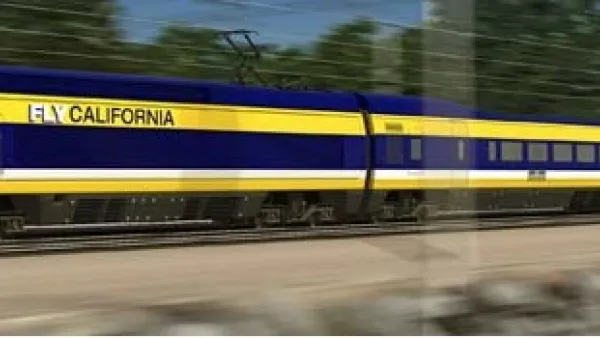While the revised business plan did shave off $30 billion, there remains a $55 billion funding shortfall. Dependent on federal and private funds that may never appear, could revenue from the sale of carbon credits bridge the funding gap?
The CA High Speed Rail project has received $3.3 billion in federal funds but remains dependent on an additional $35.3 billion, plus $13 billion in private investment, neither of which may be forthcoming soon, if at all. Gov. Jerry Brown has suggested that "cap & trade" funds, authorized by the landmark 2006 climate bill, AB 32, could provide revenue as early as November. Anywhere between $2 billion to $4 billion could come from the auction of carbon credits.
The Mercury News transportation reporter Mike Rosenberg, and environmental reporter Paul Rogers, write that the scheme "could either be a brilliant savior for the cash-strapped rail project or a disappointing enigma that disappears under legal scrutiny and opposition from businesses."
"It's the winning-the-lottery scenario," said Dorothy Rothrock, vice president of the California Manufacturers and Technology Association. "Counting on cap-and-trade revenues might not be the wise thing to do if it is so legally suspect that the money will never show up."
"At a news conference Monday in Fresno, rail leaders did little to play up the new funding possibility, nor did they return calls seeking more detail. But critics said it is likely to set off a massive legal showdown between business interests and the state."
Dan Richard, chairman of the California High-Speed Rail Authority, states in the Associated Press (via San Mateo Daily Journal, "(Cap & trade) gives us a backstop dedicated funding stream that gives us confidence that we can go forward".
The High Speed Rail board meets on April 15, Monday, to approve the revised business plan. Utilizing cap & trade funds is not on the agenda. Approval of the MOU for the blended rail agreements for northern and southern California are listed.
FULL STORY: Gov. Brown looks to global warming fees to pay for high-speed rail

Analysis: Cybertruck Fatality Rate Far Exceeds That of Ford Pinto
The Tesla Cybertruck was recalled seven times last year.

National Parks Layoffs Will Cause Communities to Lose Billions
Thousands of essential park workers were laid off this week, just before the busy spring break season.

Retro-silient?: America’s First “Eco-burb,” The Woodlands Turns 50
A master-planned community north of Houston offers lessons on green infrastructure and resilient design, but falls short of its founder’s lofty affordability and walkability goals.

Test News Post 1
This is a summary

Analysis: Cybertruck Fatality Rate Far Exceeds That of Ford Pinto
The Tesla Cybertruck was recalled seven times last year.

Test News Headline 46
Test for the image on the front page.
Urban Design for Planners 1: Software Tools
This six-course series explores essential urban design concepts using open source software and equips planners with the tools they need to participate fully in the urban design process.
Planning for Universal Design
Learn the tools for implementing Universal Design in planning regulations.
EMC Planning Group, Inc.
Planetizen
Planetizen
Mpact (formerly Rail~Volution)
Great Falls Development Authority, Inc.
HUDs Office of Policy Development and Research
NYU Wagner Graduate School of Public Service


























